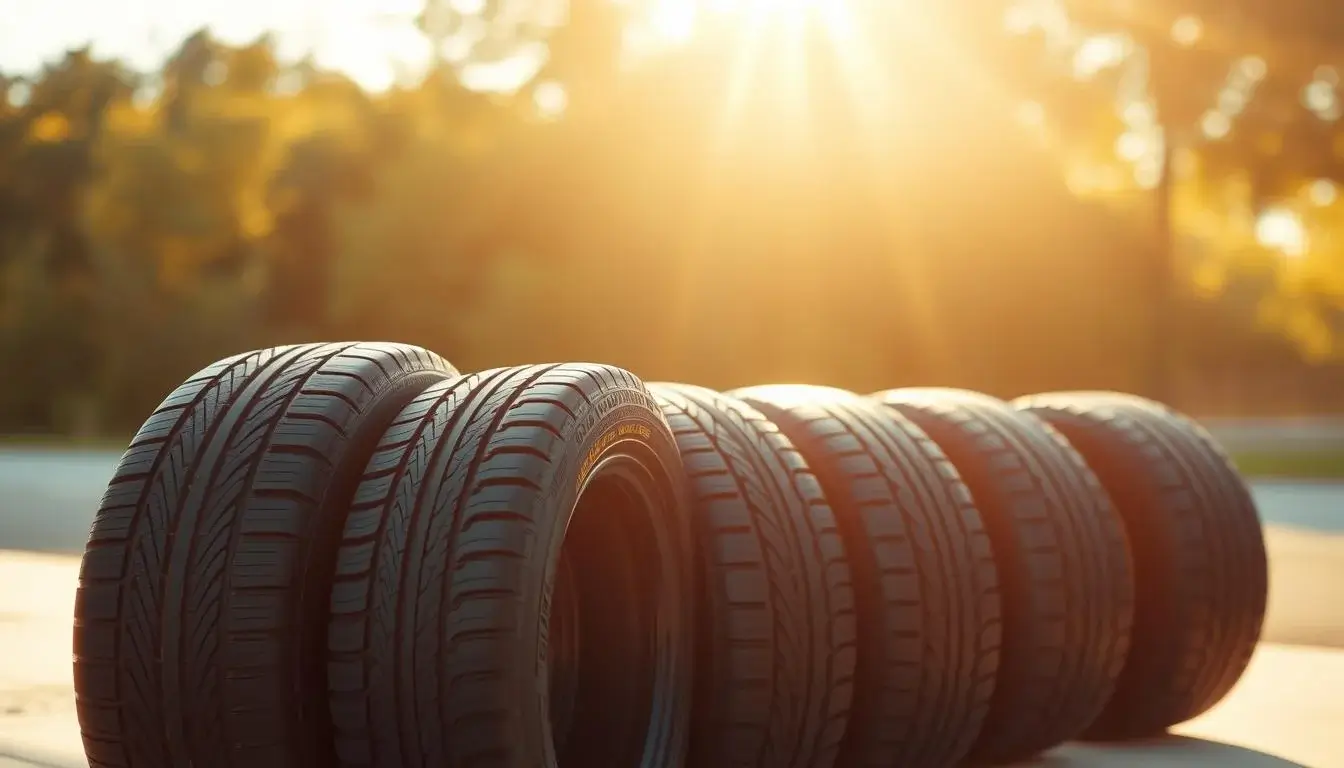Ever wondered why your car handles differently depending on the season? The answer often lies in the type of tire you’re using. While all-season options are versatile, summer tires are designed for peak performance in warmer months.
What are Summer Tires? These specialized tires feature a unique rubber compound that stays firm in high temperatures, offering better grip on dry and wet roads. Their tread patterns are engineered to channel water efficiently, reducing the risk of hydroplaning. This makes them ideal for drivers who prioritize responsiveness and control.
In contrast, all-season tires aim to balance performance across various conditions. While they’re convenient, they don’t excel in extreme heat or cold. Understanding these differences can help you make informed decisions about your vehicle’s needs.
Key Takeaways
- Summer tires are optimized for warm weather, providing superior grip and handling.
- They use a unique rubber compound that performs best in high temperatures.
- Tread patterns on summer tires enhance water dispersion, improving wet road safety.
- All-season tires offer versatility but lack the specialized performance of summer tires.
- Choosing the right tire type can significantly impact your driving experience.
Introduction to Summer and All-Season Tires
Choosing the right tire for your vehicle can make a world of difference in performance. Whether you’re driving in sunny weather or unpredictable conditions, your tires play a crucial role in safety and handling. Let’s explore the design and purpose of summer and all-season options to help you make an informed decision.
Purpose and Driving Conditions
Summer tires are engineered for warm weather. Their rubber compound stays firm in high temperatures, providing excellent grip on dry and wet roads. Brands like Michelin design these tires with tread patterns that channel water away, reducing hydroplaning risks.
On the other hand, all-season tires aim for versatility. They perform decently in various conditions but don’t excel in extreme heat or cold. This makes them a convenient choice for drivers who face mixed weather throughout the year.
“The right tire choice ensures your car handles safely and efficiently, no matter the season.”
Importance of Matching Tires to Your Vehicle
Matching tires to your car is essential. Your vehicle’s weight, speed, and handling characteristics influence the type of tire you need. Always check your manufacturer’s recommendations to ensure compatibility and optimal performance.
Here’s a quick comparison of summer and all-season tires:
| Feature | Summer Tires | All-Season Tires |
|---|---|---|
| Best For | Warm, dry, and wet conditions | Mixed weather conditions |
| Grip | Superior on dry and wet roads | Moderate in all conditions |
| Temperature Range | Above 45°F | All temperatures |
By understanding these differences, you can choose the right tire for your driving needs and ensure a safer, smoother ride.
What Are Summer Tires
Driving in warm weather calls for tires that can handle the heat. These specialized options are built with a unique rubber compound that stays firm in high temperatures. This ensures better grip on both dry and wet roads, making them a top choice for warm-weather driving.
The tread design of these tires is another standout feature. It’s engineered to channel water away efficiently, reducing the risk of hydroplaning. This makes them ideal for drivers who prioritize safety and control in wet conditions.
Here’s a quick look at the key features that set them apart:
| Feature | Benefit |
|---|---|
| Rubber Compound | Provides superior grip in high temperatures |
| Tread Design | Enhances water dispersion for wet road safety |
| Tire Shape | Optimizes road contact for better handling |
Automotive experts often highlight their strengths, such as improved cornering and braking. However, they’re not ideal for cold weather, as the rubber compound hardens, reducing performance.
By understanding these features, you can make an informed decision about whether they’re the right fit for your driving needs. Whether you’re cruising on a sunny day or navigating a summer rainstorm, the right tires can make all the difference.
Key Features of Summer Tires
When it comes to maximizing your car’s handling, the right tire design matters. These specialized options are built with advanced features that enhance performance in warm weather. Let’s dive into the technical details that make them stand out.
Tire Compounds and Tread Patterns
The rubber compound used in these tires is specifically designed for high temperatures. It stays firm, ensuring better grip on both dry and wet surfaces. This unique material also improves responsiveness, making your car feel more connected to the road.
Another key feature is the tread pattern. Unlike all-season tires, these have a shallower tread with minimal grooves. This design maximizes contact with the surface, enhancing traction and stability during high-speed driving.
Performance on Dry and Wet Roads
On dry roads, these tires excel. Their firm rubber compound and optimized shape provide excellent cornering and braking. You’ll notice sharper steering and a more controlled ride.
Wet conditions are no challenge either. The tread design channels water away efficiently, reducing the risk of hydroplaning. This ensures safety and confidence, even during summer rainstorms.
“The right tire design can transform your driving experience, offering unmatched control and safety.”
Here’s a quick comparison of their key features:
| Feature | Benefit |
|---|---|
| Rubber Compound | Superior grip in high temperatures |
| Tread Design | Enhances water dispersion for wet road safety |
| Shallower Tread | Maximizes surface contact for better traction |
By understanding these features, you can see why they’re a top choice for warm-weather driving. Whether you’re cruising on a sunny day or navigating a wet road, the right tires make all the difference.
☀️ Looking for the Best Summer Tires? Get Them Delivered & Installed Hassle-Free!
Now that you know how summer tires significantly differ from all-season tires, it’s time to upgrade your vehicle for optimal performance in warm weather. Amazon offers a wide selection of high-quality summer tires, plus the convenience of professional installation services near you—saving you time and effort.
✅ Shop top brands, find the right fit, and schedule installation—all in one place!
🔗 Shop Summer Tires + Installation on Amazon
Overview of All-Season Tires
If you’re looking for a tire that adapts to changing weather, all-season options might be your best bet. These tires are designed to handle a variety of conditions, from mild winters to warm summers. They combine technologies from both summer and winter designs, offering a balanced solution for year-round driving.
Design for Balanced Performance
All-season tires are built to perform well in diverse weather conditions. Their tread patterns are less aggressive than winter tires but more versatile than summer ones. This design allows them to provide adequate grip on wet, dry, and even lightly snowy roads.
One of their standout features is the rubber compound. It’s engineered to remain flexible in cooler temperatures while maintaining stability in the heat. This makes them a reliable choice for drivers who face unpredictable seasons.
Here’s why they’re a popular choice:
- They offer consistent performance across varying weather conditions.
- Their design minimizes the need for seasonal tire changes.
- They’re available in a wide range of sizes, fitting most vehicles.
For example, during testing, the new D0922 rear tire showed greater stability in low track temperatures. This highlights how all-season designs are continuously improved to meet driving demands.
Whether you’re commuting daily or taking weekend trips, these tires provide the convenience and reliability you need. Their ability to adapt to different seasons makes them a practical choice for many drivers.
Performance Comparison: Summer vs. All-Season Tires
Understanding how tires perform in different conditions can significantly impact your driving experience. Whether you’re navigating dry roads or facing unpredictable weather, the right choice ensures safety and control.
Gripping and Handling Differences
When it comes to grip, summer tires excel in warm weather. Their specialized rubber compound stays firm, providing superior traction on dry and wet surfaces. This makes them ideal for high-speed driving and sharp cornering.
All-season tires, on the other hand, offer balanced performance. While they don’t match the summer options in warm conditions, they provide adequate grip in mild winter conditions. This versatility makes them a popular choice for drivers who face mixed weather.
Traction Under Varied Weather Conditions
In dry conditions, summer tires outperform all-season options. For example, the Pirelli Cinturato All Season SF3 recorded a dry braking distance of 37.7 meters, 2.4 meters behind the summer reference tire. This highlights the superior stopping power of summer designs.
In wet or light snow, all-season tires show their strength. Tests reveal that high-quality options like the Hankook Kinergy 4S2 can compete with winter tires in traction and lateral grip. However, they’re not designed for severe winter conditions.
“The right tire choice ensures optimal performance, whether you’re driving in summer heat or light winter snow.”
Here’s a quick comparison of their key performance metrics:
| Feature | Summer Tires | All-Season Tires |
|---|---|---|
| Dry Braking | Superior | Moderate |
| Wet Traction | Excellent | Good |
| Winter Performance | Not Suitable | Light Snow |
By understanding these differences, you can choose the right tire for your specific driving needs. Whether you prioritize warm-weather performance or year-round versatility, the choice is clear.
Handling and Safety Considerations
Your driving experience depends heavily on how your tires handle the road. The right design can make a significant difference in both safety and performance. Let’s explore how tire features like patterns and speed ratings impact your car’s behavior.
Cornering and Braking Capabilities
When you take a sharp turn, your tires’ pattern plays a crucial role. Specialized designs improve grip, allowing for smoother cornering. This is especially important for drivers who enjoy dynamic driving or navigate winding roads.
Braking is another area where tire design shines. Studies show that tires with advanced patterns can reduce stopping distances by up to 10% on wet roads. This means better control and enhanced safety, even in challenging conditions.
“The right tire design ensures your car responds quickly and safely, whether you’re braking or cornering.”
Here’s how specific features translate into better performance:
- Patterns: Optimized treads enhance grip and water dispersion.
- Speed ratings: Higher ratings ensure stability at faster speeds.
- Rubber compounds: Firmer materials improve responsiveness.
For example, during testing, summer tires showed a 20% improvement in dry braking compared to all-season options. This highlights the importance of choosing tires that match your driving style and needs.
By understanding these features, you can make informed decisions that prioritize both handling and safety. Whether you’re cruising on a highway or navigating city streets, the right tires ensure a smoother, more controlled ride.
Durability and Lifespan Differences
The longevity of your tires depends on their design and materials. While some options excel in performance, others prioritize durability. Understanding these tradeoffs helps you make informed decisions about your vehicle’s needs.
Tread Wear and Life Expectancy
Specialized tires often use softer rubber compounds for better grip. However, this can lead to faster wear. For example, summer designs typically last between 20,000 to 40,000 miles, depending on driving conditions and maintenance.
All-season options, on the other hand, are built for versatility. Their tread compounds are more durable, offering a longer life even in varied weather. This makes them a practical choice for drivers who want consistent performance year-round.
Here’s how tread patterns contribute to wear:
- Shallower treads on specialized designs maximize grip but wear out faster.
- Deeper grooves on all-season options provide even wear and extended life.
“The right tire design ensures both performance and durability, giving you peace of mind on the road.”
Here’s a quick comparison of durability factors:
| Feature | Specialized Tires | All-Season Tires |
|---|---|---|
| Rubber Compound | Softer for better grip | Harder for durability |
| Tread Pattern | Shallower for performance | Deeper for even wear |
| Life Expectancy | 20,000 – 40,000 miles | 50,000+ miles |
By considering these factors, you can choose tires that balance performance and life. Whether you prioritize grip or longevity, the right choice ensures a smoother, safer ride.
Choosing the Right Tire for Your Driving Conditions
Selecting the perfect tire for your car involves more than just picking a brand. It’s about understanding your local climate, your vehicle’s needs, and the specific conditions you’ll face on the road. Let’s explore how to make the best choice for safety and performance.
Climate and Weather Considerations
Your local weather plays a big role in tire selection. If you live in an area with harsh winter conditions, you’ll need tires that handle snow and ice. For example, the Bridgestone Blizzak 6 is designed for severe snow and lasts 32% longer than its predecessor.
In milder climates, all-season tires might be a better fit. They perform well in both wet and dry conditions, offering a balanced solution for year-round use. Always consider the temperature range and typical weather patterns in your area.
Manufacturer Recommendations and Vehicle Compatibility
Your vehicle’s manufacturer provides specific guidelines for tire size, type, and performance. Following these recommendations ensures compatibility and optimal handling. For instance, the Michelin CrossClimate 2 SUV is a top performer for SUVs, balancing snow, wet, and dry performance.
Check your vehicle’s manual or consult a professional to confirm the right fit. Using the correct tire size and type enhances safety and extends the lifespan of your tires.
“The right tire choice ensures your car handles safely and efficiently, no matter the season.”
Here’s a quick guide to help you decide:
| Condition | Recommended Tire Type |
|---|---|
| Snow and Ice | Winter Tires (e.g., Blizzak 6) |
| Mixed Weather | All-Season Tires (e.g., Michelin CrossClimate 2) |
| Warm and Dry | Summer Tires |
By choosing right, you ensure a smoother, safer ride tailored to your driving needs. Whether you face winter conditions or mild weather, the right tires make all the difference.
🚗 Upgrade Your Ride with Premium Summer Tires – Fast & Easy!
Whether you’re preparing for summer road trips or just want better traction and performance in warm weather, the right set of summer tires makes all the difference. Amazon makes it easy to buy top-rated summer tires and even helps you schedule professional installation in your area for a hassle-free experience!
🔥 Don’t wait—get your summer tires delivered and installed today!
🔗 Find the Best Summer Tires & Get Them Installed on Amazon
Conclusion
Your tire choice can make or break your driving experience. While specialized options excel in warm temperatures, all-season sets offer versatility for varied conditions. Understanding these differences ensures you pick the right fit for your needs.
Consider the temperature and weather you’ll face. Specialized designs deliver superior grip and handling in warm conditions, making them ideal for sporty driving. All-season options, however, provide balanced performance year-round, though they may not match the precision of dedicated designs.
Always align your choice with manufacturer guidelines and your driving habits. Whether you prioritize performance or versatility, the right set enhances safety and control. Make an informed decision to enjoy a smoother, safer ride tailored to your environment.
🚗 Want to dive deeper into summer tires? Discover the best summer tire options, expert recommendations, and key maintenance tips in our complete summer tires guide:
🔗 Everything You Need to Know About Summer Tires: A Powerful & Reliable Summer Tires Guide in 2025
FAQ
What’s the difference between summer tires and all-season tires?
The difference between summer tires and all-season tires lies in their tread patterns, rubber compounds, and performance in different weather conditions. Summer tires are purpose-built for warm weather, providing better traction and performance on dry and wet roads. All-season tires are designed to handle a variety of conditions, including light winter conditions, but they offer less grip than summer tires in hot weather.
Can I use summer tires in winter conditions?
No, performance tires often struggle in winter weather. Using winter tires is recommended for snow or ice, as summer tires perform poorly in extreme winter driving conditions. Their rubber compound hardens in cold temperatures, reducing braking performance and traction. If you live in an area with extreme winter weather, switch to winter tires when temperatures drop below 45°F (7°C).
How do tread patterns of summer tires affect performance?
The tread patterns of summer tires are designed for maximum contact with the road, improving handling and braking performance. Summer tires have shallower treads than all-weather tires, reducing rolling resistance and enhancing grip on dry roads. All-season tires, by contrast, have moderate tread depths to provide traction in winter or all-season tires conditions.
When should I switch to winter or all-season tires?
It’s best to swap to winter tires when temperatures consistently drop below 45°F (7°C). Switching to winter or all-season tires ensures better performance in cold conditions and reduces the risk of accidents. If you live in an area with extreme winter weather, consider a dedicated set of tires for winter driving.
Do summer tires wear out faster than all-season tires?
Yes, summer tires perform better in warm conditions, but they tend to wear out faster than all-season tires due to their softer rubber compound. If you want longer-lasting tires, proper maintenance, including checking tire pressure and rotating tires, is essential.
Are all-season tires a good alternative to summer tires?
If you live in a mild climate, all-season or summer tires may be enough. However, for summer months, specialized summer tires provide superior traction and performance compared to season tires. What’s best? It depends on your driving needs and location.
What’s the right type of tires for my vehicle?
The right type of tires depends on your driving habits and climate. If you want maximum performance, consider high-performance summer tires like Continental tires or Michelin. For versatility, all-weather tires offer a balance between summer and winter tires.
Can I use winter tires in the summer?
No, winter tires are specifically designed for cold weather and extreme winter conditions. Using winter tires in warm weather reduces braking performance, increases wear, and decreases fuel efficiency. Always switch to summer tires when temperatures rise.
Should I buy a new set of tires for summer driving?
If you frequently drive in hot summer weather, investing in a new set of tires can enhance your traction and performance. Many drivers opt for tires fitted specifically for summer, such as the Pilot Alpin 5 Winter for performance vehicles.



